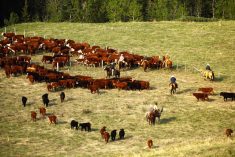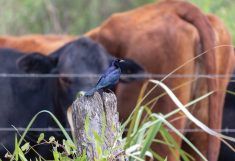Funding cuts and restructuring mean organizations such as the Beef Cattle Research Council need to change their research approach and be proactive, says the organization’s chair.
Change and downsizing is affecting both government and university research, partly because of funding woes but also because research priorities are changing, said Tim Oleksyn, a mixed cattle and grain farmer from Prince Albert, Sask.
“A lot of times we are reactionary on trying to develop the capacity of our research, now we have the insight to focus longer term,” he said.
Read Also

Mosquito-borne virus could be devastating to sheep breeding operations
Cache Valley virus, a mosquito-borne disease that infects small ruminants, could be a devastating hit to small operations.
That’s prompted the Beef Cattle Research Council to move to a cluster focus, because it fosters collaboration among researchers and produces a body of work that can have a bigger impact, he said.
“There’s less of a researcher kingdom and they’re more in tune to bring their lab and thought processes together,” he said. “It’s the whole impact of where they fit.”
The council partnered with Agriculture and Agri-Food Canada to develop its first “science cluster” in 2009 (under the first Growing Forward program). It provided $10.5 million for 32 research projects in a four-year period and that generated “meaningful, applicable results,” Oleksyn wrote in the council’s recent annual report. The second round, which runs to March 2018, will see more than $20 million go to 26 research projects.
Other priorities
The beef research council is focused on identifying research areas that are “getting left behind,” Oleksyn said in an interview.
One of the key areas getting left behind right now is forage research, he said, adding it needs to focus on more than just breeding, and include topics such as forage utilization, ecological goods and services, and the value of forage and grasslands to the beef sector and society as a whole.
“It’s tough to identify value and the return investment,” he said.
The council is also seeking to partner more with universities and colleges, and its researcher mentorship program is part of that effort. The program matches scientists who are new to the Canadian cattle scene with industry vets, with the goal of encouraging young researchers to stay in the industry; help them make contacts and better understand industry issues; and give them opportunities to share their research findings more widely.
“They already have the passion and the skill set,” said Oleksyn. “We open the highway for them and they drive the bus.”
Verified beef
In his chairman’s report, Oleksyn noted just five per cent of participants in the Verified Beef Production program have been audited and he said he hopes to see that number increase.
“We’re trying to build that better and get that program sorted out,” he said, adding many producers have moved from an older-quality program and that process takes time.
But care needs to be taken to ensure producers aren’t overloaded when it comes to showing that they are living up to animal care, environmental stewardship, and other standards, he said.
“There is always the question of what the producer will be asked to do next that add additional costs to the production model and start to be a hindrance,” he said. “This is an ongoing process.”
The council provides research and technology development for VBP, and while the program will continue to add modules, streamlining is also a priority, said Oleksyn.
“It’s the ability of being able to measure who has programs that are very similar and overlap them that will occur in one program itself,” he said. “That’s the challenge, because there are so many individual operations out there.”
















